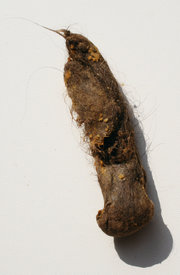

Custom Search
|
 A hairball from a long-haired
Maine Coon
cat (about 4 in/10 cm long).
A hairball from a long-haired
Maine Coon
cat (about 4 in/10 cm long).A hairball is a collection of hair or fur formed in the stomach of animals that is occasionally vomited up when it becomes too big. Cats are especially prone to hairball formation since they groom themselves by licking their fur leading to hair going into the stomach.
Cattle are also known to accumulate hairballs, but, as they do not vomit, these are found usually after death and can grow quite large.
Although uncommon in humans, some hairballs have been reported, often in young girls as a result of trichotillomania and pica. In 2003, a 3-year old girl in Red Deer, Alberta, Canada had a grapefruit-sized hairball surgically removed from her stomach and in 2004, an 18-year old woman from McAdam, New Brunswick, Canada had a 5-lb hairball surgically removed from her lower intestine. Hairballs can be quite hazardous in humans, since hair cannot be digested or passed by the human gastrointestinal system, and (assuming it is identified) even vomiting may be ineffective at removing the hair mass. This can result in the general impairment of the digestive system.
Cats, made by MultiMedia | Free content and software
This guide is licensed under the GNU Free Documentation License. It uses material from the Wikipedia.